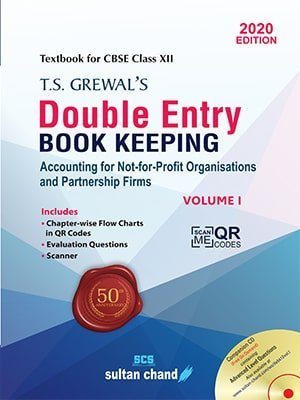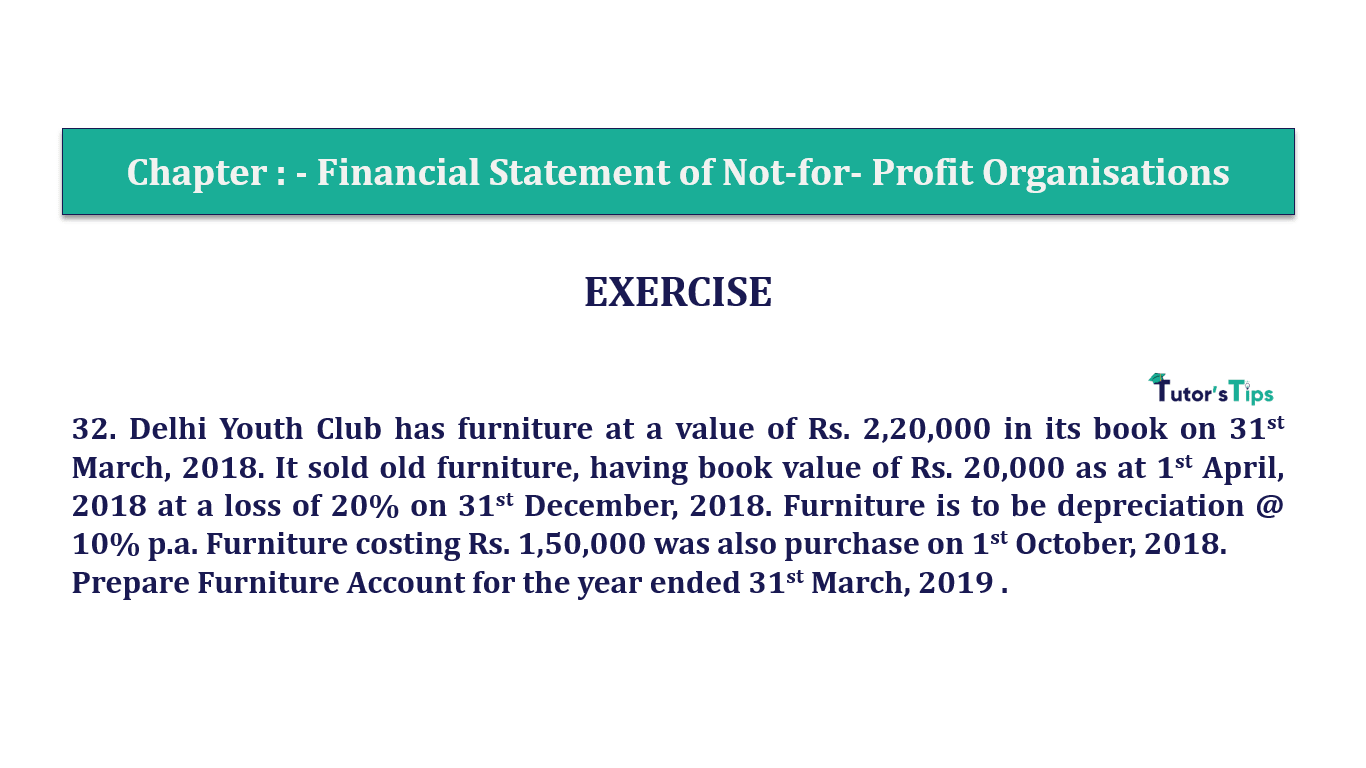Question 32 Chapter 1 of +2-A
32. Delhi Youth Club has furniture at a value of Rs. 2,20,000 in its book on 31st March 2018. It sold old furniture, having a book value of Rs. 20,000 as at 1st April 2018 at a loss of 20% on 31st December 2018. Furniture is to be depreciation @ 10% p.a. Furniture costing Rs. 1,50,000 was also purchased on 1st October 2018.
Prepare Furniture Account for the year ended 31st March 2019.
The solution of Question 32 Chapter 1 of +2-A: –
| Furniture A/c |
|||||
| Date | Particular | Amount | Date | Particular | Amount |
| 01/04/18 | To Balance b/d | 2,20,000 | 30/09/18 | By Depreciation a/c (on a sold part) see note |
1,500 |
| 01/10/18 | To Bank A/c | 1,50,000 | 30/09/18 | By Cash a/c | 14,800 |
| 30/09/18 | By loss on the sale of Furniture | 3,700 | |||
| 31/03/19 | By Depreciation a/c (on balance) see note |
27,500 | |||
| 31/03/19 | By Balance c/d (B. Fig.) | 3,22,500 | |||
| 3,70,000 | 3,70,000 | ||||
| Income and Expenditure Account |
|||
| Expenditure | Amount | Income | Amount |
| To Loss on sale of Furniture (check working note) |
3,700 | ||
| To Depreciation a/c (1500 + 20,000 + 7,500) |
29,000 | ||
| BALANCE SHEET (AN EXTRACT) as on 31st March 2019 |
|||
| Particular | Amount | Particular | Amount |
| Furniture | 3,22,500 | ||
| Statement Showing stationery used during the year |
|
| Particular | Amount |
| Book value of furniture as on 1st April, 2018 which is sold | 20,000 |
| Less: – Amount of Depreciation up to the date of sale i.e. 31st December 2018 | |
| 30,000 * 10% *9/12 | 1,500 |
| Book value of furniture as on 30th September 2018 | 18,500 |
| Less: – Loss on sale of assets @ 20% 18,500 * 20% |
3,700 |
| Sale Price of furniture | 14,800 |
Calculation of the amount of Depreciation on Balance of Furniture: –
| On Old Furniture Full-year dep. Charged |
On New Furniture From the Date of Purchase i.e. 01st October 2019 (For 6 months) |
| 2,00,000 x 10% = 20,000/- |
1,50,000 x 10% x 6/12 = 7,500/- |
Total Amount of Dep = 27,500
Not-for-Profit Organisations – Meaning and Overview
Thanks, Please Like and share with your friends
Comment if you have any questions.
Advertisement-X
Also, Check out the solved question of previous Chapters: –
T.S. Grewal’s Double Entry Book Keeping +2 (Vol. I: Accounting for Not-for-Profit Organizations and Partnership Firms)
- Chapter No. 1 – Financial Statement of Not-For-Profit Organisations
- Chapter No. 2 – Accounting for Partnership Firms – Fundamentals
- Chapter No. 3 – Goodwill: Nature and Valuation
- Chapter No. 4 – Change in Profit-Sharing Ratio Among the Existing Partners
- Chapter No. 5 – Admission of a Partner
- Chapter No. 6 – Retirement/Death of a Partner
- Chapter No. 7 – Dissolution of a Partnership Firm
T.S. Grewal’s Double Entry Book Keeping (Vol. II: Accounting for Companies)
- Chapter No. 8 – Company Accounts – Accounting for Share Capital
- Chapter No. 9 – Company Accounts – Issue of Debentures
- Chapter No. 10 – Redemption of Debentures
T.S. Grewal’s Double Entry Book Keeping (Vol. II: Accounting for Companies)
- Chapter No. 1 – Financial Statements of a Company
- Chapter No. 2 – Financial Statement Analysis
- Chapter No. 3 – Tools of Financial Statement Analysis – Comparative Statements and Common- Size Statements
- Chapter No. 4 – Accounting Ratios
- Chapter No. 5 – Cash Flow Statement
Check out T.S. Grewal +2 Book 2020@ Official Website of Sultan Chand Publication








Leave a Reply